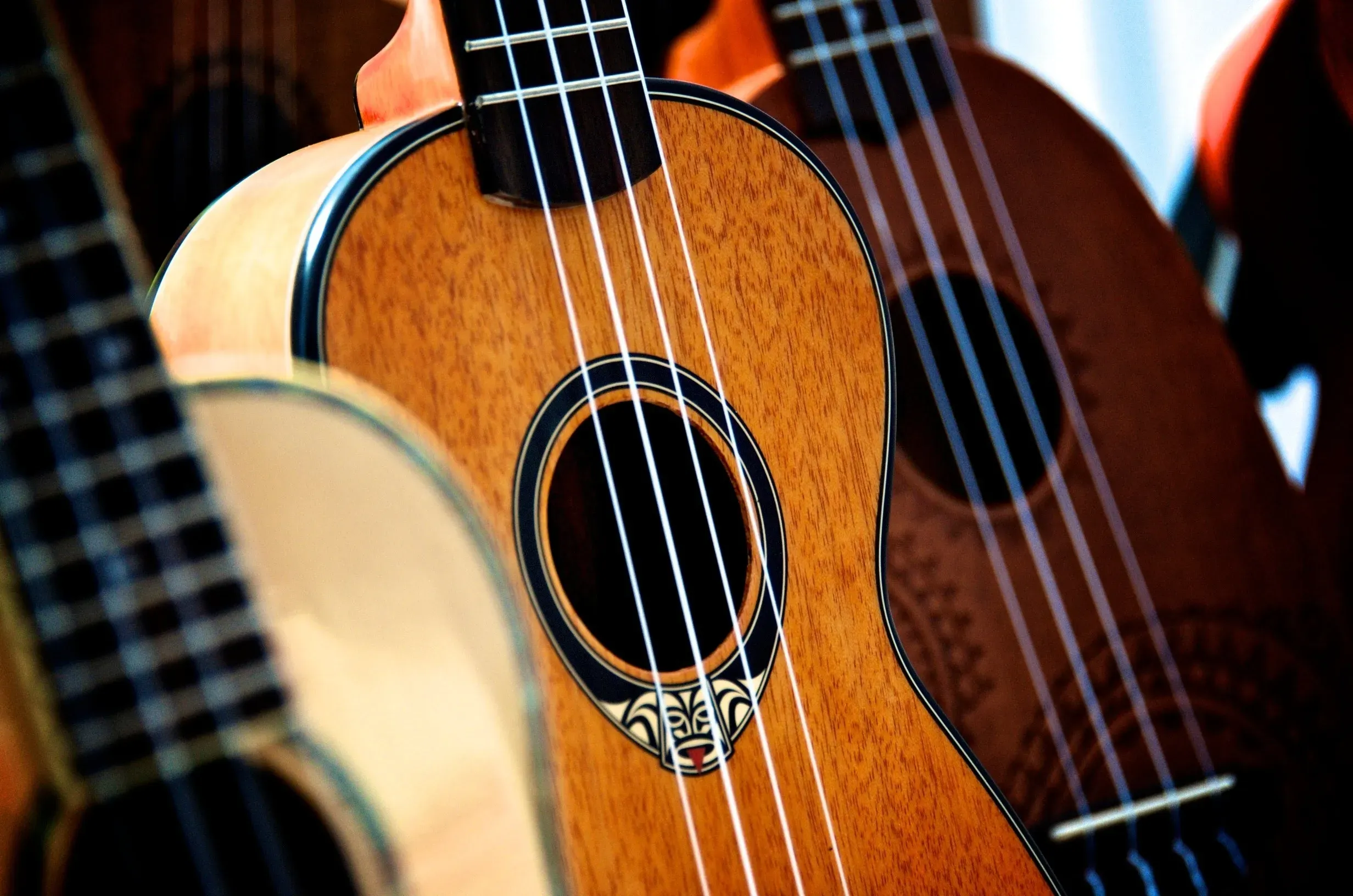Ukulele Overview
The ukulele is a string instrument from the lute family. The ukulele has its roots in the Portuguese instrument called the "machete."
The ukulele looks like a small guitar. It has a bright and cheerful sound. It produces a sweet, mellow tone that is well-suited for a variety of musical styles, ranging from Hawaiian and folk to pop and indie.
The ukulele's unique timbre is characterized by its short sustain and percussive attack. It’s kind of a chunk-a-chunk beat that adds to the charm.
The nylon strings of a traditional ukulele contribute to its warm and resonant sound and relatively high-pitched tones.
History and Origin
It originated in Portugal and was brought to Hawaii by the Portuguese immigrants.
From Portuguese to Hawaii
Its journey to Hawaii is a fascinating tale of cultural exchange. In the 19th century, Portuguese immigrants, particularly from the Madeira and Azores islands, came to Hawaii to work on sugarcane plantations. Along with their belongings and cultural practices, these Portuguese immigrants brought a musical instrument which they called - machete.
When Portuguese immigrants introduced this machete to the Hawaiian Islands in the late 19th century, it became popular among the local people. Hawaiians adapted and embraced the machete, incorporating it into their musical traditions. The instrument underwent some modifications in Hawaii, including changes in size and tuning, evolving into what we now know as the ukulele.
The Hawaiian name "ukulele" roughly translates to "jumping flea," possibly named after the rapid finger movements of players on the instrument's strings. The ukulele quickly became an integral part of Hawaiian music and culture. Its popularity continued to grow, and it eventually spread beyond Hawaii to become a widely recognized and beloved instrument around the world.
Entering the U.S. mainland
The ukulele gained attention on the U.S. mainland during the Panama-Pacific International Exposition in San Francisco in 1915. Performances by Hawaiian musicians, along with the instrument's portability and pleasant sound, contributed to its popularity.
During the Jazz Age and Big Band Era of the 1920s and 1930s, the ukulele found its way into jazz music. Its compact size made it suitable for ensemble playing, and it became a popular rhythm instrument.
In the mid-20th century, the ukulele experienced a revival with the folk music movement. Artists like Arthur Godfrey and Tiny Tim contributed to its popularity. The instrument found its way into pop culture, making appearances in movies and television shows.
George Harrison, a member of The Beatles, was known for his interest in and experimentation with various instruments, including the ukulele. One notable instance is George Harrison's use of the ukulele in the song "Free as a Bird." This song was released by The Beatles in 1995, decades after the band had officially disbanded. "Free as a Bird" was part of the Anthology 1 album, a compilation of unreleased tracks and alternative versions.
Traveling to Japan
The ukulele traveled to Japan in 1929 and rose in popularity among Western music enthusiasts. It even survived the temporary ban on Western music during World War II. It reclaimed its glory after the war ended. Hawaiian music and ukulele remain the most favored among music lovers in Japan.
In Canada
In 1960 it was introduced in schools in Canada as an inexpensive alternative to other musical instruments. It received a quick acceptance making a record of 50000 schoolchildren and adults learning to play the instrument. It remains an integral part of music classes in schools in Canada.
Today, the ukulele is embraced in various musical genres, including pop, rock, indie, folk, and more. Musicians around the world explore its versatility, and the instrument continues to evolve as players experiment with different playing techniques and styles.
Ukulele Mechanics and Structural Components
The ukulele has four strings and a small, figure-eight-shaped body. The construction of a ukulele involves several key components and processes, each contributing to the instrument's overall design, tone, and playability.
The combination of these elements, along with the craftsmanship involved in their assembly, contributes to the unique character and quality of each ukulele.
The construction process requires precision and attention to detail to ensure the instrument's playability and tonal excellence.
Different builders may use variations in materials and construction techniques, leading to a diverse range of ukulele styles and characteristics.
The mechanics of a ukulele refer to its structural components and how they contribute to the instrument's functionality, tone, and playability. Here are the key mechanics of a ukulele:
The Body
The body of a ukulele is typically made from wood. Common tonewoods include mahogany, koa, spruce, cedar, and others. The choice of wood significantly influences the instrument's tone and resonance.
Top
The top of the ukulele, known as the soundboard, is a crucial component that vibrates and produces sound. It is often made of a resonant wood, such as spruce or cedar. The quality of the soundboard and its bracing pattern impact the ukulele's tone.
Neck
The neck provides support for the fretboard and connects the body to the headstock. It is commonly made of mahogany or other hardwoods. The neck angle and profile affect playability.
Fretboard
The fretboard is usually made of durable wood like rosewood or ebony. It contains frets, which are metal strips embedded into the wood. The frets divide the neck into segments, allowing the player to change the pitch of the notes.
Frets
Frets are thin metal strips embedded along the fretboard. They determine the pitch of the notes when the strings are pressed against them. Proper fret placement is crucial for accurate intonation.
Bridge
The bridge is located on the body of the ukulele and anchors the strings. It transfers the vibrations from the strings to the soundboard, contributing to the instrument's resonance. The materials used for the bridge include - rosewood, ebony, mahogany, bones, or synthetic materials. The choice of material for the bridge affects the ukulele's tone.
Saddle
The saddle is a small piece, usually made of bone or synthetic materials, positioned on the bridge. It helps transmit vibrations from the strings to the soundboard and influences the intonation.
Nut
The nut is located at the top of the neck, near the headstock. It supports and spaces the strings, contributing to proper string alignment and intonation. Nuts are commonly made of materials like bone or synthetic materials.
Headstock
The headstock, or head, is located at the top of the neck and often bears the ukulele's tuning pegs. It can be designed in various shapes, adding to the instrument's aesthetic appeal.
Tuning Pegs
Tuning pegs are used to adjust the tension of the strings, thereby tuning the ukulele. They can be made of metal or other materials and come in different styles.
Finish
The finish on a ukulele serves both protective and aesthetic purposes. It helps protect the wood from environmental factors and enhances the instrument's visual appeal. Common finishes include gloss, satin, or natural.
Types of Ukulele
There are several types of ukuleles, each distinguished by its size, tuning, and tonal characteristics. The four main types of ukuleles are soprano, concert, tenor, and baritone. Additionally, there are variations and less common types, such as the sopranino and bass ukuleles.
Soprano Ukulele
The smallest and most traditional ukulele size with around 13 inches (33 cm) scale length. It has a standard tuning of G4-C4-E4-A4.
The Soprano Ukulele is known for its bright and cheerful sound. A popular choice for beginners and those who appreciate the classic ukulele sound.
Concert Ukulele
Slightly larger than the soprano in size, with a scale length of around 15 inches (38 cm), tuned at a standard G4-C4-E4-A4.
It offers a slightly warmer and fuller tone compared to the soprano. The larger body allows for more resonance.
Tenor Ukulele
The tenor is larger than the concert with a scale length of 17 inches (43 cm). It provides more room on the fretboard. The standard tuning for a tenor is G4-C4-E4-A4.
The tenor is known for its deeper and richer tone. Preferred by musicians for solo playing, fingerstyle, and those who want a bit more space on the fretboard.
Baritone Ukulele
The Baritone is the largest among all the standard ukuleles with a scale length of around 19 inches (48 cm). It is tuned at D3-G3-B3-E4 (similar to the top four strings of a guitar).
The baritone ukulele produces a more mellow and guitar-like sound. Offers a different playing experience due to its size and tuning.
Sopranino Ukulele
Also known as the piccolo and sopranissimo, the sopranino ukulele is the smallest in size with a scale length of 11 inches (28 cm). The tuning is similar to that of soprano - G4-C4-E4-A4.
Sopranino is known for its compact size and high pitch. Less common than other types but appreciated for its unique sound.
Bass Ukulele
The bass is larger than tenor or baritone ukuleles. The scale length varies but is generally longer than other ukuleles. Its tuning is similar to the traditional bass guitar (E1-A1-D2-G2).
The bass is designed to produce lower frequencies, providing a bass-like sound in a compact and portable instrument.
Tonal Quality of the Ukulele
The tone and volume of a ukulele are crucial aspects that contribute to the instrument's overall character and appeal. These qualities are influenced by various factors, including the ukulele's size, tonewoods, construction, strings, and playing technique.
Smaller ukuleles, like the soprano, often produce a bright and cheerful tone, while larger ones, such as the tenor or baritone, have a deeper and richer sound.
The choice of tonewoods, such as mahogany, koa, spruce, or cedar, significantly influences the instrument's unique tonal characteristics.
The design and construction of the ukulele, including the bracing of the soundboard, also play a crucial role in determining its resonance and tonal balance.
The type of strings used, whether nylon or fluorocarbon, contributes to the overall warmth or brightness of the sound.
Additionally, the player's technique, including strumming patterns and fingerpicking style, has a direct impact on the perceived tone, allowing for a wide range of expressive possibilities.
Volume of the Ukulele
In terms of volume, the size of the ukulele is a contributing factor, with larger instruments generally producing more volume due to their larger sound chambers. However, smaller ukuleles can still project well and are well-suited for intimate settings.
The choice of tonewoods, particularly dense woods like mahogany or koa, can enhance the projection of sound.
Additionally, a well-constructed soundboard with effective bracing contributes to the ukulele's resonance, influencing its overall volume.
The gauge and tension of the strings also play a role, with thicker strings generally producing more volume, albeit with potential challenges in playability.
The player's technique, including the intensity of strumming or picking, further influences the perceived volume of the ukulele.
Despite not being as loud as larger string instruments, the ukulele's volume is often considered suitable for small gatherings, solo performances, or acoustic settings, contributing to its popularity across various musical genres and settings.
Ukulele Playing Techniques
Most ukulele playing techniques are similar to other string instruments such as guitar and mandolin. Some of the techniques are mentioned here -
Strumming
A fundamental ukulele technique involves a rhythmic up-and-down motion across the strings. For a relaxed and natural flow, maintain a comfortable hand position, allowing your wrist to move freely.
Ukulele players experiment with fingerstyle or a pick. The strumming intensity can vary to have dynamic control over the rhythm and the melody.
The practitioners strum different patterns, accents, and techniques like palm muting and chucking to add depth and expressiveness. And also adjust the strumming speed based on the song's tempo.
Fingerpicking
Fingerpicking involves using the fingers to pluck individual strings, creating a melodic or harmonic pattern. Various fingerpicking styles, such as Travis picking or clawhammer, add complexity and richness to the music.
Hammer-Ons and Pull-Offs
Hammer-ons occur when a player taps a finger onto the fretboard to produce a higher note without picking the string again. Pull-offs involve lifting a finger to produce a lower note without picking.
Tremolo
Tremolo is when the player makes a rapid repetition of a single note or alternation between two notes. The motion is a quick back-and-forth movement of the fingers on a single string, creating a sustained, fluctuating sound often described as trembling or shimmering. Tremolo is applied to add expressiveness, dynamics, and a sense of vibrato to a melody line or a single note.
This may sound like strumming but there is a fundamental difference. While strumming is a broader technique used for chords and rhythmic accompaniment, tremolo is a more specialized technique focused on achieving a sustained and expressive effect through rapid note repetition.
Famous Ukulele Players
Several musicians have gained fame and recognition for their skillful and innovative ukulele playing.
These musicians have not only showcased the ukulele's versatility but have also contributed to its popularity across different genres and regions.
Their unique styles and contributions have inspired countless players and continue to shape the perception of the ukulele in the world of music.
Here are some notable ukulele players:
Israel Kamakawiwo'ole
Often referred to as "Iz," Kamakawiwo'ole was a Hawaiian musician known for his soulful voice and ukulele playing. His medley of "Somewhere Over the Rainbow/What a Wonderful World" became iconic.
Jake Shimabukuro
A virtuoso ukulele player, Shimabukuro has gained international acclaim for his remarkable technique and versatility. He has covered a wide range of genres and is known for his energetic and expressive performances.
Kevin Carroll
Kevin Carroll is a member of the Texas Music Educators Association, an instructor at ukulele workshops around the world, a performing and recording artist, and a teacher of both private and group music lessons. He published his first book "Ukulele Ceilidh" in February 2019. Kevin practices Texas-based music, blues, soul, funk, Celtic, Classical, African, and differentiated ukulele ensembles.
Eddie Vedder
The lead vocalist of Pearl Jam, Eddie Vedder, is also an accomplished ukulele player. He has released solo albums featuring his ukulele playing, showcasing a more intimate and stripped-down side of his musical talents.
Irwin Silbernik
Irwin Silbernik has been practicing guitar, piano, ukulele, and mandolin for decades. He has a talent for connecting with students and designing lessons to meet their diverse needs. Irwin majored in piano and instrumental music education at both DePaul University and the University of Illinois in Champaign/Urbana. He has been a part of the De Paul University Symphony Orchestra, which regularly performed in Chicago's Orchestra Hall.
Roy Smeck
Roy Smeck, often referred to as the "Wizard of the Strings," was a multi-instrumentalist, including the ukulele. He was a prominent figure in the early 20th century, known for his impressive technique and showmanship.
Das Gunjan
Das Gunjan is a highly trained guitar and Ukulele coach. He has an impressive teaching experience of fifteen years. He teaches Guitar to those who want to learn it as a hobby, to those who aim at getting certifications, and to those who aspire to become professional artists.










